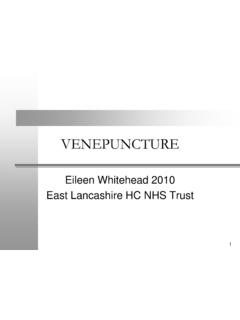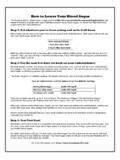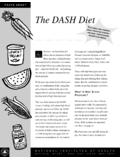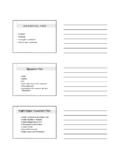Transcription of Blood Glucose Monitoring - DUE East Lancashire | NHS ...
1 Blood Glucose MonitoringEileen Whitehead 2010 East Lancashire HC NHS Trust1 Blood GlucoseMeasuring the amount of Blood Glucose in the Blood helps to evaluate ? How the body is converting and breaking down foods that are eaten How the liver is working How the organs in the body that help regulate Blood Glucose are working 2 Blood GlucoseHow can Blood Glucose be measured? Fasting Blood sugar test Oral Glucose tolerance test Random Blood Glucose test Self- Monitoring of Blood Glucose (finger prick) 3 Blood Glucose A fasting Blood Glucose testis the preferred method to diagnose diabetes and rule out other conditions This test is done after a person has had nothing to eat or drink except water for at least 8 hours. It is generally started overnight so the test can be done in the morning4 Blood Glucose An oral Glucose tolerance testrequires a person to drink a pre-measured amount of a Glucose drink. Then 2 hours later a Blood Glucose measurement is done.
2 If the Blood Glucose is high then another test is done on a different day to confirm whether the person has diabetes. Usually the fasting Blood Glucose test or the random Glucose test is done5 Blood Glucose A random Blood Glucose testis done shortly after a person has eaten or had something to drink. Usually if a level is high, a fasting Glucose test or oral Glucose tolerance test is done6 Blood Glucose A self-monitoringtestor Blood Glucose Monitoring by finger prick is a quick and easy method of identifying problems with Blood sugar levels7 Blood GlucoseThere are some contraindications to capillary sampling, what are they? Localised areas of infection Cyanotic, poorly perfused tissues Inflamed, swollen or oedematous tissues Previous puncture sites 8 Blood GlucoseThere are also some complications of capillary sampling, what are they? Pain Local trauma Damage to nerves, Blood vessels and bones Excessive Blood loss Infection9 Blood Glucose However, because Blood Glucose readings obtained from the fingertip are the most closely correlated with arterial Glucose levels, the fingertip should be considered the optimal site Considerations: The side of the finger is generally less sensitive than the tip of the finger10 Blood Glucose Sensitivity may be lost in tips of fingers if used regularly Rotation of sites is advised to avoid painfuland hard skin forming11 Blood GlucoseWhat do the test results mean?
3 Results of each individual test will vary. The normal Blood Glucose levels vary depending on which test was performed, whether a person was fasting before the test, and whether any special dietary or Glucose substances were given during testing12 Blood Glucose Increased levels of Blood Glucose , a condition known as hyperglycaemia, may be caused by the following: Acromegaly, a condition that causes elongation of the bones of the limbs and head Cushing syndrome, a condition in which the level of the hormone cortisol is too high and causes fatigue and weakness, protein loss, swelling, and diabetes mellitus13 Blood Glucose Diuretics Gestational Diabetes Infection in the pancreas Kidney failure Liver Disease14 Blood Glucose Pheochomocytoma, which is a noncancerous tumour that causes an increase in certain chemicals that can cause high Blood pressure Steroid medications such as prednisone Stress response, including infection, severe burns, or surgery 15 Blood Glucose Decreased levels of Blood Glucose , a condition known as hypoglycaemiamay indicate the following.
4 Addison's disease a condition in which there is a decreased amount of the adrenocorticol hormone Blood lossextensive liver disease Hypopituitarism which is a condition in which the pituitary gland does not release enough hormone16 Blood Glucose Hypothyroidism,a condition in which too little thyroid hormone is present in the Blood Insulin overdose Malabsorption,or inadequate absorption of nutrients from the stomach or intestines Starvation 17 Blood GlucoseWhat is a 'normal range'? The simple answer would be the Blood Glucose levels maintained in all non diabetic people. In practice, normal ranges quoted from various sources differ. This is partly because it depends on the Blood sample and partly because there is a good deal of variation within the general population and a grey area between 'normal' and 'diabetic' cut-off points18 Blood GlucoseBlood Glucose LevelUK units millimoles per mmol/1On thelow mmol/1 Too low< -hypoglycaemicToo high> Glucose20 Blood GlucoseWhat advice can we give to patients to help maintain their Blood sugar ?
5 Eat several smaller meals throughout the day Keep snacks handy, avoid long periods without food. Aim for lower glycaemic carbohydrate foods such as whole grains and vegetables -A high glycaemic food will cause a larger fluctuation in Blood sugar than a low glycaemic food21 Blood Glucose Keep meals balanced -include lean protein sources such as chicken or fish Fill up on fibre, this stabilizes Blood sugar levels and keep them more consistent Exercise can lower Blood sugar , eat healthy carbohydrate rich snacks before performing any exercise and fuel up on food afterwards22 Blood Glucose Include healthy fats from sources such as nuts or olive oil. Fats are digested more slowly than carbohydrates and protein and may therefore help to stabilize Blood sugar levels and prevent headache pain Don't skip breakfast23 Blood Glucose What are the advantages of maintaining Blood sugars? Beyond the obvious conclusion that preventing late-life disease would benefit the ageing hippocampus, our findings suggest that maintaining Blood sugar levels, even in the absence of diabetes, could help maintain aspects of cognitive health.
6 Channel 4 News March 201024 Blood GlucoseA recent report linked high Blood sugar levels with: Cancer Diabetes Heart DiseaseMaintaining Blood sugar Levels GlucoseProcedure for capillary Blood samplingYou will need to learn your equipment each monitor is slightly different 26 Blood GlucoseEquipment Blood Glucose testing meter Box of test strips Lancet Cotton wool or gauze swabs Non-sterile gloves Sharps container 27 Blood GlucoseCommunication Introduce yourself Explain what you would like to do and why Gain consent for the procedure28 Blood GlucoseProcedure Wash hands and put on gloves With the metre switched off, remove a test strip from the foil exposing only the black and white electrode bars Insert the test strip into the metre test port with the electrode bars facing up29 Blood Glucose Slide the remainder of the foil off the strip being careful not to pull the strip from the meter (save the foil packet to discard used test strip)
7 The meter should automatically turn on and momentarily display all the LED icons, then a 5 digit number. Ensure that this number matches that printed on the foil packet for the test strip. If this is not the case it needs re calibrating30 Blood Glucose When the message apply Blood is displayed obtain the capillary Blood sample(see seperate slides) Hold the meter loaded with the test strip, so that the white target area of the test strip touches the surfaceof the drop of Blood . Hold this position until enough Blood is drawn into the test strip to completely fill the target area and the meter displays --- A 20 second countdown will flash on the meter screen and the Glucose value will display31 Blood Glucose Record the results appropriately , including patients identity, date and time of test, the result and the ID of the person performing the test Remove the test strip from the meter using the foil packet to help confine Blood waste and dispose into sharps container32 Blood Glucose Obtaining the Blood sample.
8 Clean the finger (washing will do) Encourage Blood flow (keep finger warm) Prepare the lancet device (manufacturers instructions) Hold the device firmly against the finger and press the release button Dispose of lancet into sharps bin33 Blood Glucose Wait 6 seconds to allow Blood to flow and milk from the bottom of the finger to the puncture site Continue this process until a drop of Blood is obtained from the puncture site Load the Blood onto the test strip Once sufficient Blood has been obtained wipe the puncture site with clean swab and apply pressure until bleeding stops Dispose of clinical waste34 Blood Glucose35 Blood GlucoseReferences: Maintaining Blood sugar Levels Channel 4 News March 2010 Zachary. T. Bloomgarden, MD (2003) Blood Glucose Monitoring Wallymahmed M (2007) Capillary Blood Glucose Monitoring . Nursing Standard21,38.










